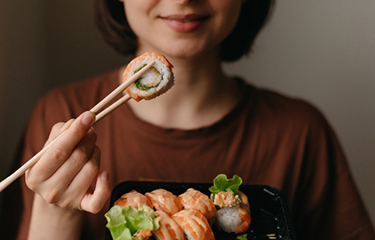NOTE: This story was originally published in October in SeafoodSource’s Key Buyer 2023 Industry Update – Fall Edition.
Sushi aside, promoting prepared foods has plummeted on supermarkets’ list of marketing priorities in 2023, according to foodservice research and consulting firm Datassential.
Back in 2019 and 2020, retailers and foodservice operators alike were spotlighting prepared entrees with equal vigor, Datassential Chief Business Officer Dave Jenkins said. However, beginning in 2021, supermarkets started easing off the segment – a distancing that has only intensified since.
“By February of this year, restaurant promotional activity was three times that of supermarkets, based on Datassential’s monthly promotional tracking of the top 250 foodservice chains, including the top 35 supermarkets,” Jenkins noted in a recent Datassential blog post.
The competition is especially fierce when it comes to the prepared food space, Jenkins said, with supermarkets competing against both independent restaurants and chains.
However, prepared sushi is a segment staple with staying power for grocery providers. Over the past four years, sushi’s share of promotional activity among supermarkets shot up to 5 percent, “more than doubling its share in 2019,” per Datassential.
“While sushi can be found at a variety of restaurants, it is primarily found at Japanese restaurants. There are just over 20,000 Japanese restaurants in the U.S. and just over 5,000 of those are limited-service restaurants where takeout and delivery are primary service segments. With sushi, supermarkets have found a product that is difficult to prepare, growing in popularity, and has very limited distribution … a formula that is not too different from fried chicken and pot pies,” Jenkins said.
This formula has served Cincinnati, Ohio, U.S.A.-based Kroger well, as recent reports have established the grocery chain operator as the top seller of sushi in the U.S. Last year, Kroger sold a whopping 44 million sushi rolls, a spokesperson for the company told Business Insider in August 2023.
Kroger, which contracts with Snowfox/JFE Franchising as a primary source of prepared sushi products, offers an array of ready-to-eat sushi items, including crunchy combo and spicy combo boxes. The company’s California crunch roll is its most popular cooked sushi product, while its rainbow roll is its leading raw offering.
“When customers think of sushi, we want them to think of Kroger,” Kroger Chief Marketing Officer Stuart Aitken told the Wall Street Journal in August. According to the newspaper, sushi sales at U.S. retailers rose 72 percent over the past year.
While inflation has taken a slight nibble out of demand for prepared sushi at retail this year, Category Partners Senior Vice President of Marketing Eric Le Blanc believes such products have bigger grocery gains ahead.
“Sushi growth has been explosive over the past few years and certainly benefited during the pandemic,” Le Blanc told SeafoodSource in June. “Clearly, sushi has not reached the end of its growth trajectory, even though the total market is leveling off.”
Younger consumers have played a large part in enhancing sushi’s retail popularity. Earlier this year, Morning Consult asked Generation Z consumer respondents what their favorite foods were, and rounding out the top five – behind pizza, chicken (13 percent), pasta (11 percent), and burgers (7 percent) – was sushi (6 percent).
210 Analytics Principal Anne-Marie Roerink has picked up on this trend, too. Prepared sushi products provide retailers with “a great way … to get these younger generations into the deli-prepared foods area of the store,” she said.
As retailers embrace sushi-selling with newfound fervor, several high-end sushi omakase restaurants in New York City, U.S.A. have had to rethink their approach. Michelin-starred Sushi Ginza Onodera, for instance, closed its doors in August of this year, with General Manager Yoko Yamaguchi citing oversaturation in New York’s high-end omakase scene.
“[There has been a] significant increase in the number of high-end omakase counters, [and this market transformation] is one of the reasons we have decided to move on to the next phase,” Yamaguchi told Bloomberg in August, adding that she is planning to open a more affordable restaurant in the future that will appeal to a broader clientele.
Two other omakase restaurants in the city – Kotaru and Sushi Noz – have also shifted down their pricing, now charging USD 140 to USD 159 (EUR 128 to EUR 146), instead of as much as USD 375 to USD 495 (EUR 344 to EUR 454).
“[It’s a] great entry point to the world of high-end omakase without the intimidating price tag,” Sushi Noz Co-Owner Joshua Foulquier said.
Linda Wang, who operates seven sushi restaurants in the Big Apple, keeps all of her menu prices under USD 110 (EUR 100).
“I wanted an omakase-quality sushi restaurant that people like me – at that time 23 years old and fresh out of college – could afford,” Wang said of her pricing strategy. “[The cost] is just not realistic for most people.”
The number of sushi restaurants in the U.S. has increased by 4 percent in 2023 compared to 2022, with more than 19,740 businesses accounted for as of 18 September, per market research firm IBIS World.
“Sushi establishments have grown in popularity as a result of consumers’ increased health consciousness and disposable income levels. Industry growth has been further supported by the expanding palates of U.S. consumers who are increasingly seeking diverse ethnic cuisines. Nevertheless, the industry contended with challenges stemming from the Covid-19 outbreak,” according to IBIS World.
Wealthier consumers “have a greater ability to spend on sushi meals” in U.S. restaurants, IBIS World added in its analysis.
“Still, many sushi chains have popped up to cater to price-conscious customers,” the firm noted.
Photo courtesy of Shutterstock/Nadia Stepaniuk







